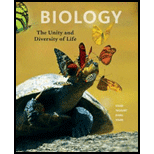
Concept explainers
Introduction: Most animals have excretory organs with a tubular structure. Body fluids enter into the one end of the tube. As these fluids enter through the tube, water and essential solutes leave the tube and return to the body fluid. Waste continues to the end of the tube and is eliminated from the body.
Answer to Problem 1SQ
Correct answer:
Option c. is given as “Malpighian tubules”. It removes the nitrogenous waste.
Therefore, optionc. is correct.
Explanation of Solution
Reasons for the correct statement:
Malpighian tubules are tubular excretory organs that deliver nitrogenous waste and other substances to the waste-processing portion of the digestive tract.
Hence, optionc. is correct.
Reasons for the incorrect statements:
Option a. is given as “nephridia”. A nephridium takes up coelomic fluid, adjusts its content, and releases waste through a pore in the body wall.
Therefore, option a. is an incorrect answer.
Option b. is given as “nephrons”. Nephrons are tiny tubules present in the kidney that produce urine.
Therefore, option b. is an incorrect answer.
Option d. is given as “contractile vacuoles”. The contractile vacuole that is present in the cell involves in osmoregulation.
Therefore, option d. is an incorrect answer.
Hence, options a, b., and d. are incorrect answers.
An insect’s malpighian tubules deliver nitrogen-rich waste to its gut.
Want to see more full solutions like this?
Chapter 40 Solutions
Biology: The Unity and Diversity of Life (MindTap Course List)
- calculate the questions showing the solution including variables,unit and equations all the questiosn below using the data a) B1, b) B2, c) hybrid rate constant (1) d) hybrid rate constant (2) e) t1/2,dist f) t1/2,elim g) k10 h) k12 i) k21 j) initial concentration (C0) k) central compartment volume (V1) l) steady-state volume (Vss) m) clearance (CL) AUC (0→10 min) using trapezoidal rule n) AUC (20→30 min) using trapezoidal rule o) AUCtail (AUC360→∞) p) total AUC (using short cut method) q) volume from AUC (VAUC)arrow_forwardQUESTION 8 For the following pedigree, assume that the mode of inheritance is X-linked recessive, and that the trait has full penetrance and expressivity and occurs at a very low frequency in the hum population. Using XA for the dominant allele and Xa for the recessive allele, assign genotypes for the following individuals (if it is not possible to figure out the second allele of a genotype, that with an underscore): 2 m 1 2 1 2 4 5 6 7 8 9 IV 1 2 3 5 6 7 8 CO 9 10 12 13 V 1, 2 3 4 5 6 7 8 9 10 11 12 13 a. Il-1: b. 11-2: c. III-3: d. III-4: e. If individuals IV-11 and IV-12 have another child, what is the probability that they will have a boy with the disorder?arrow_forwardAnswerrarrow_forward
- please,show workings ahd solutions calculate the questions showing the solution including variables,unit and equations all the questiosn below using the data a) B1, b) B2, c) hybrid rate constant (1) d) hybrid rate constant (2) e) t1/2,dist f) t1/2,elim g) k10 h) k12 i) k21 j) initial concentration (C0) k) central compartment volume (V1) l) steady-state volume (Vss) m) clearance (CL) AUC (0→10 min) using trapezoidal rule n) AUC (20→30 min) using trapezoidal rule o) AUCtail (AUC360→∞) p) total AUC (using short cut method) q) volume from AUC (VAUC)arrow_forwardQuestion about consensus and the relationship to transcriptional activityarrow_forwardQuestion about archaea and eukaryotic general transcription homologsarrow_forward
- Question about general transcription factors and their relationship to polymerasesarrow_forwardIdentify the indicated structure?arrow_forwardrewrite: Problem 1 (Mental Health): The survivor victim is dealing with acute stress and symptoms of a post-traumatic stress disorder (PTSD) due to their traumatic experience during the January 2025 wildfire. Goal 1: To alleviate the client's overall level, frequency, and intensity of anxiety and PTSD symptoms so that daily functioning remains unimpaired. Objective 1: The client will learn and regularly use at least two anxieties management techniques to reduce anxiety symptoms to less than three episodes per week. Intervention 1: The therapist will provide psychoeducation about anxiety and PTSD, including their symptoms and triggers. The therapist will also teach and assist the client in adopting relaxation techniques, such as deep breathing exercises and progressive muscle relaxation, to better manage anxiety and lessen PTSD symptoms.arrow_forward
- O Macmillan Learning You have 0.100 M solutions of acetic acid (pKa = 4.76) and sodium acetate. If you wanted to prepare 1.00 L of 0.100 M acetate buffer of pH 4.00, how many milliliters of acetic acid and sodium acetate would you add? acetic acid: mL sodium acetate: mLarrow_forwardHow does the cost of food affect the nutritional choices people make?arrow_forwardBiopharmaceutics and Pharmacokinetics:Two-Compartment Model Zero-Order Absorption Questions SHOW ALL WORK, including equation used, variables used and each step to your solution, report your regression lines and axes names (with units if appropriate) :Calculate a-q a) B1, b) B2, c) hybrid rate constant (1) d) hybrid rate constant (2) e) t1/2,dist f) t1/2,elim g) k10 h) k12 i) k21 j) initial concentration (C0) k) central compartment volume (V1) l) steady-state volume (Vss) m) clearance (CL) AUC (0→10 min) using trapezoidal rule n) AUC (20→30 min) using trapezoidal rule o) AUCtail (AUC360→∞) p) total AUC (using short cut method) q) volume from AUC (VAUC)arrow_forward
 Concepts of BiologyBiologyISBN:9781938168116Author:Samantha Fowler, Rebecca Roush, James WisePublisher:OpenStax College
Concepts of BiologyBiologyISBN:9781938168116Author:Samantha Fowler, Rebecca Roush, James WisePublisher:OpenStax College Biology: The Unity and Diversity of Life (MindTap...BiologyISBN:9781305073951Author:Cecie Starr, Ralph Taggart, Christine Evers, Lisa StarrPublisher:Cengage Learning
Biology: The Unity and Diversity of Life (MindTap...BiologyISBN:9781305073951Author:Cecie Starr, Ralph Taggart, Christine Evers, Lisa StarrPublisher:Cengage Learning
 Biology: The Unity and Diversity of Life (MindTap...BiologyISBN:9781337408332Author:Cecie Starr, Ralph Taggart, Christine Evers, Lisa StarrPublisher:Cengage Learning
Biology: The Unity and Diversity of Life (MindTap...BiologyISBN:9781337408332Author:Cecie Starr, Ralph Taggart, Christine Evers, Lisa StarrPublisher:Cengage Learning Biology 2eBiologyISBN:9781947172517Author:Matthew Douglas, Jung Choi, Mary Ann ClarkPublisher:OpenStax
Biology 2eBiologyISBN:9781947172517Author:Matthew Douglas, Jung Choi, Mary Ann ClarkPublisher:OpenStax





